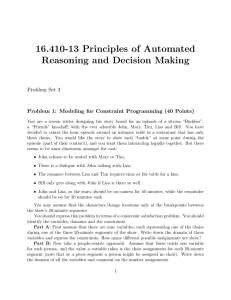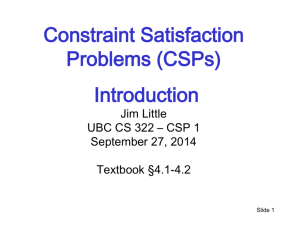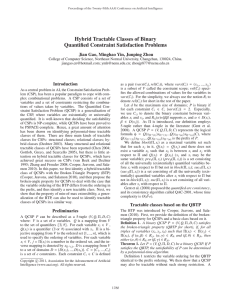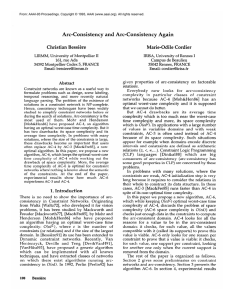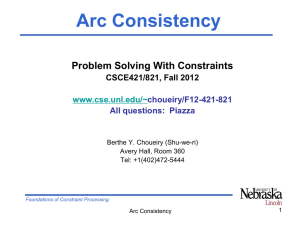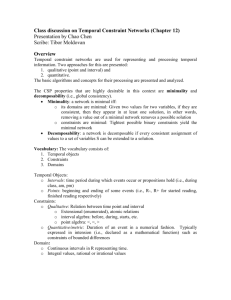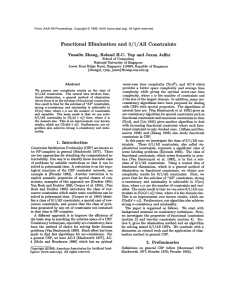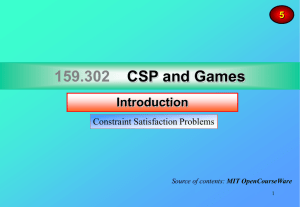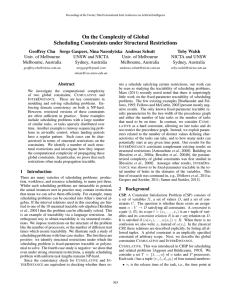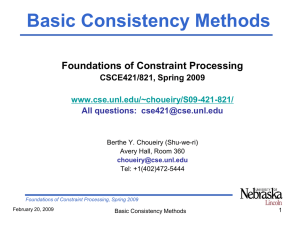from the second lecture on Constraints on AI in
advertisement
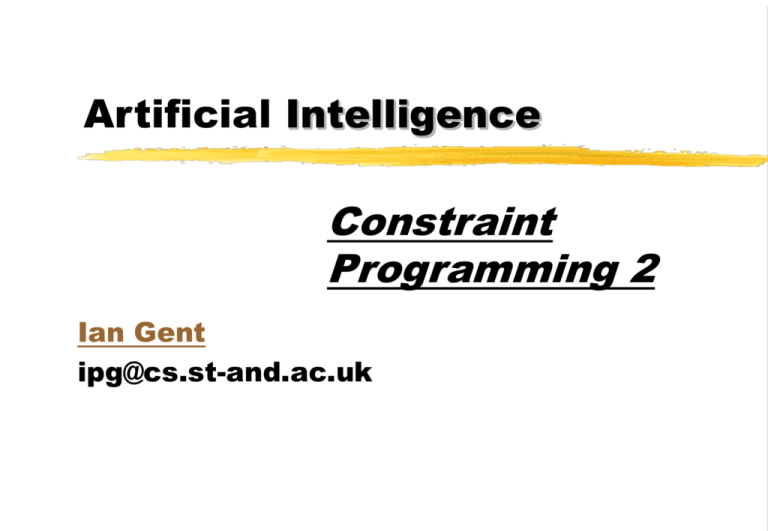
Artificial Intelligence
Constraint
Programming 2
Ian Gent
ipg@cs.st-and.ac.uk
Artificial Intelligence
Part
Part
Part
Part
I:
II:
III:
IV:
Constraint
Programming 2
Arc Consistency
MAC
Special kinds of constraints
Formulation
Constraint Satisfaction Problems
CSP = Constraint Satisfaction Problems
A CSP consists of:
a set of variables, X
for each variable xi in X, a domain Di
Di is a finite set of possible values
a set of constraints restricting tuples of values
if only pairs of values, it’s a binary CSP
A solution is an assignment of a value in Di to each
variable xi such that every constraint satisfied
3
Formal Definition of Constraints
A constraint Cijk… involving variables xi, xj, xk …
is any subset of combinations of values from Di, Dj, Dk …
I.e. Cijk... Di x Dj x Dk …
indicating the allowed set of values
Most constraint programming languages/toolkits
allow a number of ways to write constraints:
e.g. if D1 = D2 = {1,2,3} …
{ (1,2), (1,3), (2,1), (2,3), (3,1), (3,2) }
x1 x2
CtNeq(x1,x2)
I’ll use whatever notation seems right at the time
4
Arc Consistency
Last time, we saw forward checking
extremely simple form of reasoning
if variable x has value v
& constraint involves variables x-y
& constraint disallows x=v, y = u,
then remove value u from domain of y
This time, look at a more complex form of reasoning
arc consistency
In graph theory, arc = edge
In constraints, arc will be a (directed) constraint
5
Arc Consistency
Arc consistency is based on a very simple concept
if we can look at just one constraint and see that x=v is
impossible …
obviously we can remove the value x=v from consideration
How do we know a value is impossible?
If the constraint provides no support for the value
e.g. if Dx = {1,4,5} and Dy = {1, 2, 3}
then the constraint x > y provides no support for x=1
we can remove x=1 from Dx
6
Arc Consistency Propagation
When we remove a value from Dx, we may get new
removals because of it
E.g. Dx = {1,4,5}, Dy = {1, 2, 3}, Dz= {2, 3, 4, 5}
x > y, z > x
As before we can remove 1 from Dx, so Dx = {4,5}
But now there is no support for Dz = 2,3,4
So we can remove those values, Dz = {5}, so z=5
Before AC applied to y-x, we could not change Dz
This can cause a chain reaction
7
Establishing Arc Consistency
If we consider every constraint and full propagation,
there are only two possibilities:
the final problem will be arc-consistent
every value in every domain is supported by some
other value in every constraint
we have established arc consistency
at some point some variable will have an empty domain
no value can be given to that variable
the problem is insoluble due to arc consistency
we have seen a domain wipe out
A number of algorithms can be used to establish AC 8
AC3
AC3 is one of many algorithms (1 - 7 and lots more!)
Only consider binary constraints with 2 variables
For this algorithm, we revise directed arcs
I.e. when considering constraint x-y we remove values
from y
when considering y-x we remove values from x
of course both constraints are really the same one
AC3 can be done in polynomial time, em3
(e = number of constraints in problem, m = domain size)
emphasises that AC does not solve CSP’s
9
AC3
Set Q = List of all arcs (directed constraints)
While (Q not empty)
remove the first arc y-x from Q
revise the arc y-x
I.e. if all values in Dx supported by element of Dy do nothing
else remove any values from Dx not supported by y
for all constraints involving x (including x-y)
– add the arc x-y to Q if not already a member
If Dx empty, fail (domain wipe out)
If no Domain empty, succeed (established AC)
10
Exercises
Describe AC3 as a search algorithm
in terms of the generic search algorithm
so what’s the search problem?
Consider the constraints x < y, y < z, z < x
obviously inconsistent, and AC on its own can prove this
Show what AC3 does when Dx= Dy= Dz={1,2,3,4,5,6,7,8,9}
Describe a constraint satisfaction problem which …
is not arc-consistent but we can establish AC
but the problem has no solution
11
Maintaining AC (MAC)
Like any other propagation, we can use AC in
search
I.e. search proceeds as follows:
establish AC at the root
when AC3 terminates, choose a new variable/value
re-establish AC given the new variable choice (I.e.
maintain AC)
repeat;
backtrack if AC gives domain wipe out
The hard part of implementation is undoing effects of
AC
12
Special kinds of Consistency
Some kinds of constraint lend themselves to special
kinds of arc-consistency
Consider the all-different constraint
the named variables must all take different values
not a binary constraint
can be expressed as n(n-1)/2 not-equals constraints
We can apply (e.g.) AC3 as usual
But there is a much better option
13
All Different
Suppose Dx = {2,3} = Dy, Dz = {1,2,3}
All the constraints xy, yz, zx are all arc consistent
e.g. x=2 supports the value z = 3
the single ternary constraint AllDifferent(x,y,z) is not!
We must set z = 1
Generalised Arc Consistency applies to n-ary
constraints (but complicated and expensive)
A special purpose algorithm exists for All-Different to
establish GAC in efficient time
Special purpose propagation algorithms are vital
14
Formulation of CSP’s
All-different is an example of the importance of
formulation
all-different(x,y,z) much better than xy, yz, zx
even though logically equivalent
In general, it’s hard to find the best formulation
Remember DONALD + GERALD = ROBERT
The formulation I gave had just 2 constraints
all-different and a complicated arithmetic constraint
All-different fine, but neither FC nor MAC can do
much with the arithmetic constraint
15
Cryptarithmetic Revisited
FC cannot propagate until only one variable left in
constraint
AC cannot propagate until only two variables left
When coded in ILOG Solver, search backtracks
8018 times
How can we formulate the problem better?
Hint: we’d like to consider the sum in each column
separately
16
DONALD + GERALD = ROBERT
One solution is to add more variables to the problem
Variables C1, C2, C3, C4, C5
Ci represents carry from previous column i
DCi = {0,1}
Now we can express more constraints
D + D = 10*C1 + T
C1 + L + L = 10*C2 + R
C2 + A + A = 10*C3 + E
C3 + N + R = 10*C4 + B
C4 + O + E = 10*C5 + O
C5 + D + G = R
17
This shouldn’t work ?!?
We’ve made the problem bigger, so how can it
help?
Before, there were 93 107 possibilities
now there are 25 = 32 times as many!
The constraints now involve fewer variables
constraint propagation can happen sooner
variables can be set sooner (reduced to one value)
domain wipe out & backtracking occurs earlier
In ILOG Solver, this encoding needs only 212
down from 8,018
if that doesn’t impress you, call it minutes (or hours)
18
